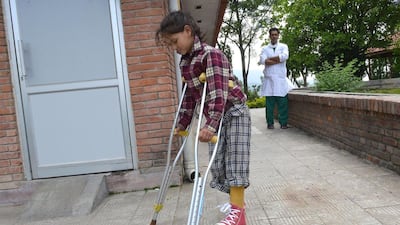Banepa, Nepal // Eight hours after Bim Bahadur Gurung started walking along a mountain path, carrying his severely injured daughter on his back and hoping to find a hospital, a second earthquake struck Nepal.
As the rocks tumbled and the earth shook, Mr Gurung never thought of stopping, desperate to see 10-year-old Maya receive a prosthetic replacement for her leg, crushed when their house collapsed in the first devastating quake.
“I could see landslides, but what could we do? I had to get her to a hospital, otherwise her life would be over,” the father-of-four said.
Mr Gurung finally reached the hospital on the outskirts of Kathmandu where he had been told Maya could be fitted with an artificial limb. Her leg was healing well after doctors amputated below the knee following the disaster.
Maya is among thousands of Nepalese who face a daunting future after suffering loss of limbs, spinal and other permanent injuries in the twin quakes that claimed more than 8,700 lives.
Although they survived the disaster and received medical help, they face enormous challenges with Nepal’s unforgiving terrain, limited infrastructure and scant rehabilitation services.
Since the first quake on April 25, tents donated by Unicef and other agencies have taken over hospital grounds, housing dozens of children and their families awaiting operations including on destroyed limbs.
“What we are seeing is the tip of the iceberg, we have a huge, huge challenge in front of us,” Bibek Banskota, director of the HRDC hospital, where Maya was brought and treated, said.
“Once the dust settles, we are going to see many more cases. Even under normal circumstances, it takes months, maybe years, for a poor villager’s kid with a broken leg to make it to our hospital,” the orthopaedic surgeons said.
HRDC is one of only a few hospitals in Nepal to make and fit artificial limbs and provide physiotherapy for disabled children.
Although HRDC staff have organised mobile clinics in the hardest-hit districts and treated hundreds of patients daily, help is still out of reach for those living in the most remote areas, Dr Banskota said.
“We desperately need to scale up capacity, go door-to-door and find the kids who need help before monsoons arrive and access to roads becomes impossible,” he said.
Handicap International estimates 18,000 people sustained injuries in the quakes, many of them fractures. And experts warn delays in identifying and treating them could lead to permanent disability.
As international aid floods in, experts also caution against accepting expensive prosthetic limbs from the West that cannot be replaced easily, a scenario that emerged in other disaster zones including quake-hit Haiti in 2010.
Sarah Blin, Nepal director for Handicap International, said prosthetics should be made locally where they can be bought cheaply even by poor families and easily altered and replaced when needed.
At HRDC, workers turn out artificial limbs using inexpensive materials such as melted sewage pipes and locally available resins.
“We are grateful for donations, but the fact is that extra funds help much more than donated prostheses — for every prostheses that is donated, we could make ten or more here for the same price,” Dr Banskota said.
Costs of prostheses at HRDC, where production is being ramped up to meet the new demand, range from $10 to $500 (Dh37 to Dh1,836) for the lightest, most comfortable ones.
Long-term care of disabled survivors is also a major challenge, with a lack of physiotherapy services in Nepal to help them cope.
No Nepalese institutions currently offer degrees in occupational therapy or orthotics and prosthetics, resulting in a shortage of trained professionals, Handicap International’s Ms Blin said.
“The skills are just not there: we have 60 people in the entire country who are trained in these fields, all trained in India.”
They also face monumental difficulties getting around in the impoverished country, which lacks even basic disabled-friendly infrastructure such as ramps, lifts and toilets.
With reconstruction of the capital set to begin, the government is being urged to consider disabled quake victims.
But for those living in remote, mountainous villages like Kashigaon where Mr Gurung earns 5,000 rupees (Dh184) a month for his family from farming, such debates are a world away.
Nearly six weeks after her home’s roof crushed her left leg, Maya’s wounds have healed, allowing Dr Banskota to fit her a prosthetic. She is bravely practising on crutches before learning to walk on her own.
As she stretches her new leg, the shy schoolgirl seems undaunted by the challenges ahead.
“I like my new leg, in time I am sure I will be able to walk easily with it,” she said.
“First, I will go back to school ... then, when I grow up, I will open a teashop in my house.
“I won’t need to walk much to do that — I can stay home and earn money by selling tea to tourists,” she said.
*Agence France-Presse

